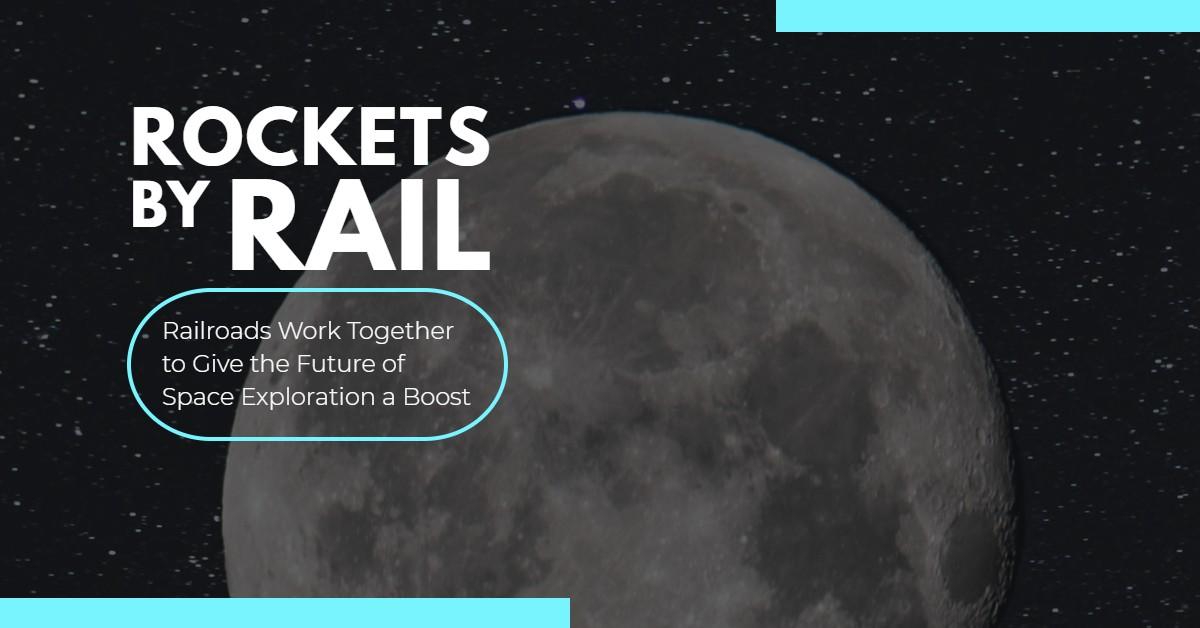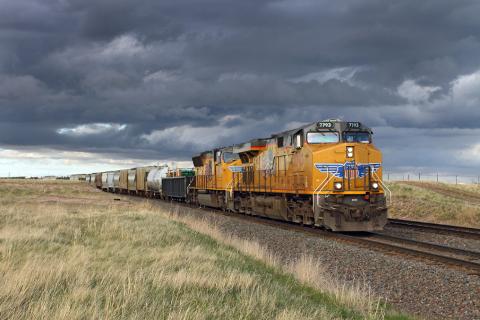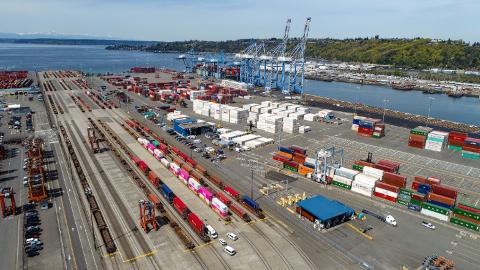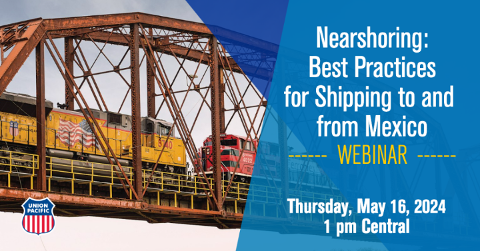Several years of careful planning and collaboration recently led up to what could be called one of the most instrumental rail shipments to advance the next generation of deep space exploration. On June 15, 2020, one of the first critical components for NASA’s upcoming mission, Artemis I, arrived by rail at Kennedy Space Center in Florida.
Artemis I is the first flight in a series of increasingly complex missions that will provide a foundation for a new era of space exploration, landing the first woman and next man on the Moon in 2024 — and ultimately leading to expanded exploration on Mars. This uncrewed flight will test NASA’s Space Launch System (SLS), the most powerful rocket ever built to explore beyond Earth’s orbit, and its Orion spacecraft together. The mission also will ensure a safe crew module entry, descent, splashdown and recovery for subsequent Artemis flights. What’s more, this important endeavor marks the beginning of a new era, demonstrating a commitment and capability to extend human existence to the Moon and further exploration in deep space.
So, when the need arose to move the most powerful rocket boosters ever created from the manufacturing facility in Utah all the way to Kennedy Space Center in Florida, who answered the call? Railroads, of course.
Preparing for the Mission

Two rail cars that carry the aft rocket motor segments were retrofitted with a heating/cooling unit to keep the highly sensitive equipment at an optimal temperature during transit.
In 2018, Union Pacific, Norfolk Southern Railroad and Florida East Coast Railway began preparations to ship the rocket boosters — produced by Northrop Grumman in conjunction with NASA — from Corinne, Utah, to Florida’s Space Coast. From the get-go, it was clear this would not be your everyday, run-of-the-mill rail shipment. This cross-country move would take extensive planning and extreme attention to detail to pull off successfully. The two massive rocket boosters — consisting of 10 individual segments, weighing in at 180 tons each — would require extra special care along each and every mile of their journey.
“The fully assembled boosters for NASA’s Space Launch System rocket are the largest, most powerful solid propellant boosters ever built for flight,” said Bruce Tiller, manager of the SLS Boosters Office at NASA’s Marshall Space Flight Center in Huntsville, Alabama, in a NASA press release. “These enormous rocket motors help provide the necessary launch power for the SLS deep space rocket.”
Not to mention, the SLS rocket is the only rocket capable of sending astronauts, the Orion spacecraft and additional cargo to the moon in a single flight.
Customizing Rail Cars
Due to their tremendous size and weight, the mission-critical rocket segments needed to be shipped in specially outfitted rail cars to safely make the 2,800-mile trip. Being the only railroad owning 200-ton flatcars outfitted for moving the oversized equipment, Union Pacific was ready to assist. The UP mechanical engineering team got to work, making sure the flatcars would be ready to carry the 13-foot wide and 32-foot long rocket booster segments.
They retrofitted two of the flatcars with heating/cooling units to keep the two aft segments and nozzles at an optimal temperature of 75 degrees Fahrenheit. David Tuma, manager Mechanical Engineering at Union Pacific, created the overall design of the rack and application to the cars for the heating, ventilation and air conditioning (HVAC) units.
“With NASA’s transition to the new SLS boosters, the size of the boosters’ nozzles was increased to improve performance. The new design required changes to the materials used to produce them, and some of those new materials are more sensitive to extreme temperatures during transit. With this shipment planned for the middle of summer, an efficient design and effective application of the cooling units was critical,” David said.
Enlisting Logistics Experts
In addition to getting the mechanical engineering team involved, the UP team enlisted the help of the logistics and supply chain management experts at Loup Logistics to help coordinate the complex shipment from start to finish.
"The Loup team worked diligently with Northrop Grumman to ensure the modified flatcars with rocket motors were properly documented for safe transit from origin to destination. They also worked closely with our contacts at the rail facilities to coordinate the accurate placement of the rail cars,” said John Marshbanks III, consultant at Loup.
Due to the extreme heft of the shipment, car placement in the train “consist” (or the sequence of rail cars) required careful planning. To distribute the weight evenly across the entire train, “buffer cars” were placed in between each of the customized flatcars carrying the booster rocket motor segments. Each buffer boxcar is filled with 50,000 pounds of concrete to improve train handling.
“It was a lot like putting a puzzle together in that each car had to be placed in a specific spot,” John added.
Keeping the Shipment Secure from Origin to Destination
Each rocket motor segment is secured to the deck of their respective flatcar via a chock/ring securement system. This is the same securement system that was used for the rocket motor segments on NASA’s Space Shuttle Program. The rocket motor is covered with a large “clam shell” for protection from the elements and is then instrumented with various sensors to detect and record g-forces during the entire trip.
In addition to accommodating for the shipment’s weight, the planning team, which included representatives from all three railroads, had to consider its sheer size – meticulously going over all dimensions, every mile of possible routes, and the different scenarios that could arise. After thorough evaluation, the team identified a cross-country route that could be cleared easily and would meet strict infrastructure requirements — avoiding any obstructions or impediments along the way. The team also determined the same Union Pacific locomotives would be used throughout the shipment’s entire trip to limit handling at each interchange.
To Kennedy Space Center and Beyond

NASA Space Launch System booster rocket motor rail shipment making its way to NASA’s Kennedy Space Center in Florida.
After years in the making, the big day finally arrived. On June 5, 2020, Union Pacific departed the rocket booster train from Northrop Grumman in Corinne, Utah. The first and longest leg of the train’s journey took roughly four days across Union Pacific’s rail lines, traveling all the way to Memphis, Tennessee. Thanks to careful planning, the trip went even smoother than expected. Lonnie Ortez, UP manager, Marketing & Sales, played a critical role in planning and executing the transport of the rocket boosters.
“We were anticipating up to five days of travel time from Corinne, Utah, to Memphis, due to the nature of the shipment, but Union Pacific cleared the way for this monumental move and made it to the interchange with Norfolk Southern in roughly four days,” he said.
Upon arrival in Memphis, Norfolk Southern crews took over the shipment for the second leg to Jacksonville, Florida.
“All said and done, NS had possession of the shipment for just under 36 hours – just another day on the railroad, as they say,” said a Norfolk Southern representative. “Getting spacecraft into orbit may take a rocket booster, but getting a rocket booster to a launch pad, well, that takes a railroad.”
And then, it was Florida East Coast Railway’s turn. On June 15, after 10 days of travel across 2,800 miles, the flight hardware for the Artemis program had arrived. Florida East Coast Railway successfully delivered the rocket boosters to NASA at the Jay Jay Rail Yard in Titusville, Florida – fewer than 20 miles from the Kennedy Space Center launch site.
“As NASA prepares to begin the next generation of space exploration, the FEC was pleased to play a role in moving the booster segments headed to the Kennedy Space Center. We are proud of the joint preparation between Northrop Grumman, NASA, NS, UP and the FEC that made this move an on-time success,” said Florida East Coast Railway’s Vice President of Carload Logistics Chris Groover.
Working Together Leads to Sweet Success

Union Pacific locomotives powering the booster rocket motor train through a tunnel and across a bridge on its way to NASA’s Kennedy Space Center in Florida. (NASA Photo)
The success of this project would not have been possible without collaboration between the railroads, careful planning between multiple internal departments, as well as countless meetings with all railroads and the customer, Northrop Grumman. Being in sync was critical – and the three railroads made it look easy. “For nearly 30 years during the Space Shuttle Program, Union Pacific and the supporting railroads were essential in providing safe, reliable shipments from Utah to the Kennedy Space Center. That railroad legacy lives on with the recent shipment of the SLS booster segments in June. Moving these oversized booster segments by rail is essential since it’s the only practical way to ship this flight-critical hardware to NASA,” said Northrop Grumman’s Integrated Logistics Program Manager Brian Christensen.
Louis Connaghan, manager, Network Operations at UP, was heavily involved in making sure every detail was addressed from the planning phase all the way through to the shipment’s final delivery.
He added, "The high level of planning and teamwork, which began in 2018, both internally and externally between the three handling railroads, went a long way in ensuring this movement went smoothly from departure to delivery. Everyone involved displayed a tremendous amount of professionalism and dedication to the mission."
What’s Next?
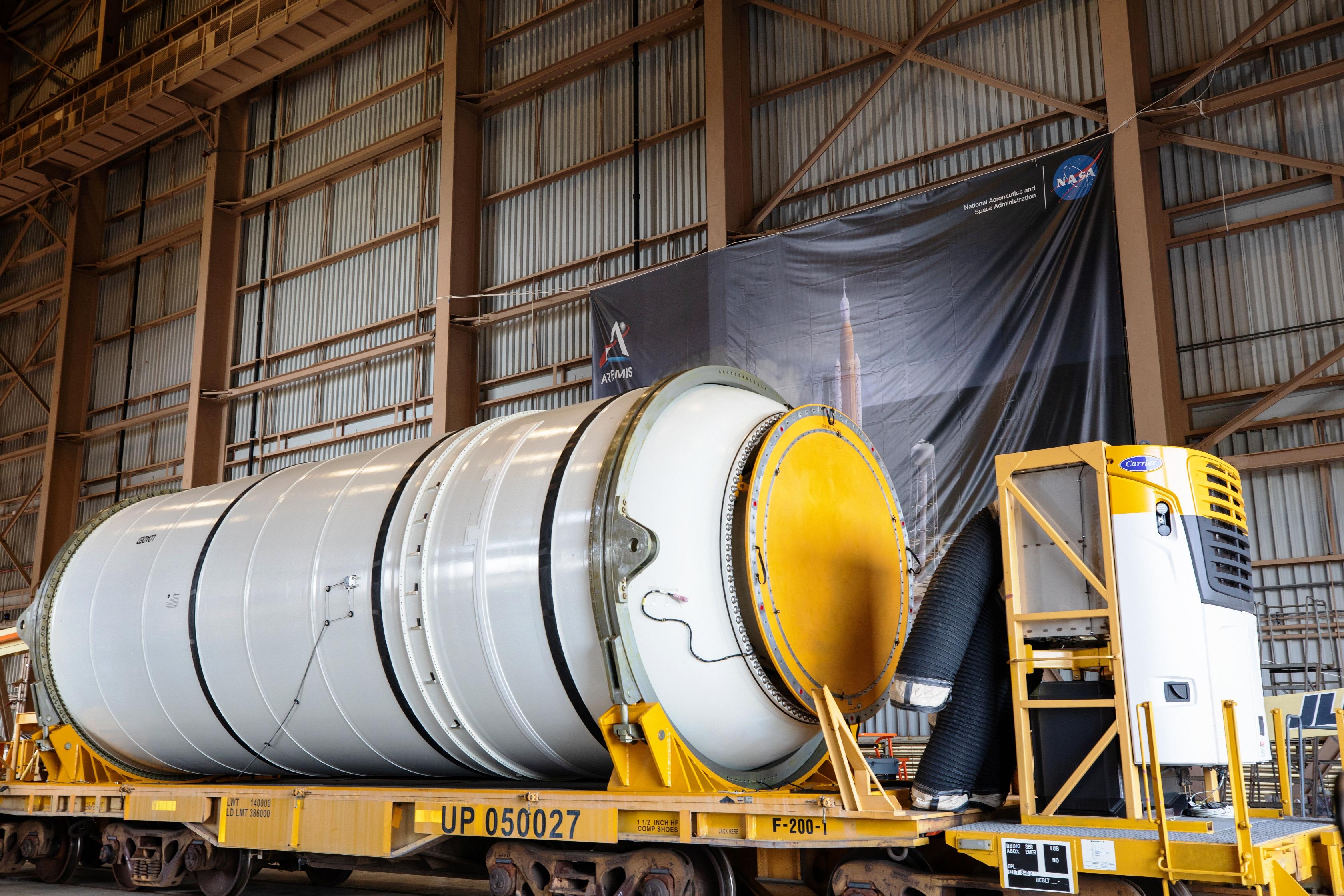
Unloading a NASA Space Launch System booster aft rocket motor segment from a Union Pacific flatcar upon arrival at Kennedy Space Center. This particular rail car was retrofitted with a heating/cooling unit (shown at the far right) to keep the highly sensitive equipment at an optimal temperature during transit. (NASA Photo)
According to NASA, now that the booster segments are at the Kennedy Space Center, their Exploration Ground Systems team will offload them from the rail cars and begin preparation for assembly and integration activities. The Artemis I mission is anticipated to launch next year ─ 2021.
As for the future of rail, with the successful completion of the high-profile rocket booster shipment, railroads are entering a whole new realm of shipping opportunities for oversized loads.
Lonnie added, “The success of this movement and the proven convenience of transporting large shipments over long distances via rail has opened up more opportunities to move more rockets and other large equipment for space exploration in the future.”
Learn More
Rail is the perfect shipping option for oversized loads. Beyond rocket boosters, trains ship many other sizable items, including military equipment and wind turbine components.
Have an oversized shipment of your own that needs to be transported over a long distance? Looking for an efficient, reliable shipping option? Reach out to us, and we can put you in touch with a shipping expert. Or, learn more about shipping dimensional loads by rail here.
Related Articles
- Ammunition for Growth: How a Former Military Facility Transformed into a Rail-Served Transportation Hub
- From the Auto Factory to the Local Dealership
- Quiz: Is Rail the Right Fit for Your Shipments?
- Stories from around the Railroad during COVID-19
- Transportation Modes Revealed: Rail
- What Can You Ship by Rail?

